Hydrogen Cars in India (2025): Rise Beyond EVs
Hydrogen cars in India are stepping out of the pilot phase: the National Green Hydrogen Mission funds production and mobility pilots; NTPC has handed over hydrogen fuel-cell buses in Leh, Ladakh, supported by a green H₂ station; Toyota Mirai continues government-backed pilots; and new schemes under SIGHT target electrolyzer manufacturing and vehicles. Still, infrastructure is nascent, costs must fall, and battery EVs remain more energy-efficient for mainstream passenger cars. Hydrogen will likely shine first in buses, trucks, and fleet use, then select private mobility segments as stations scale.
1) What Exactly Are Hydrogen Cars?
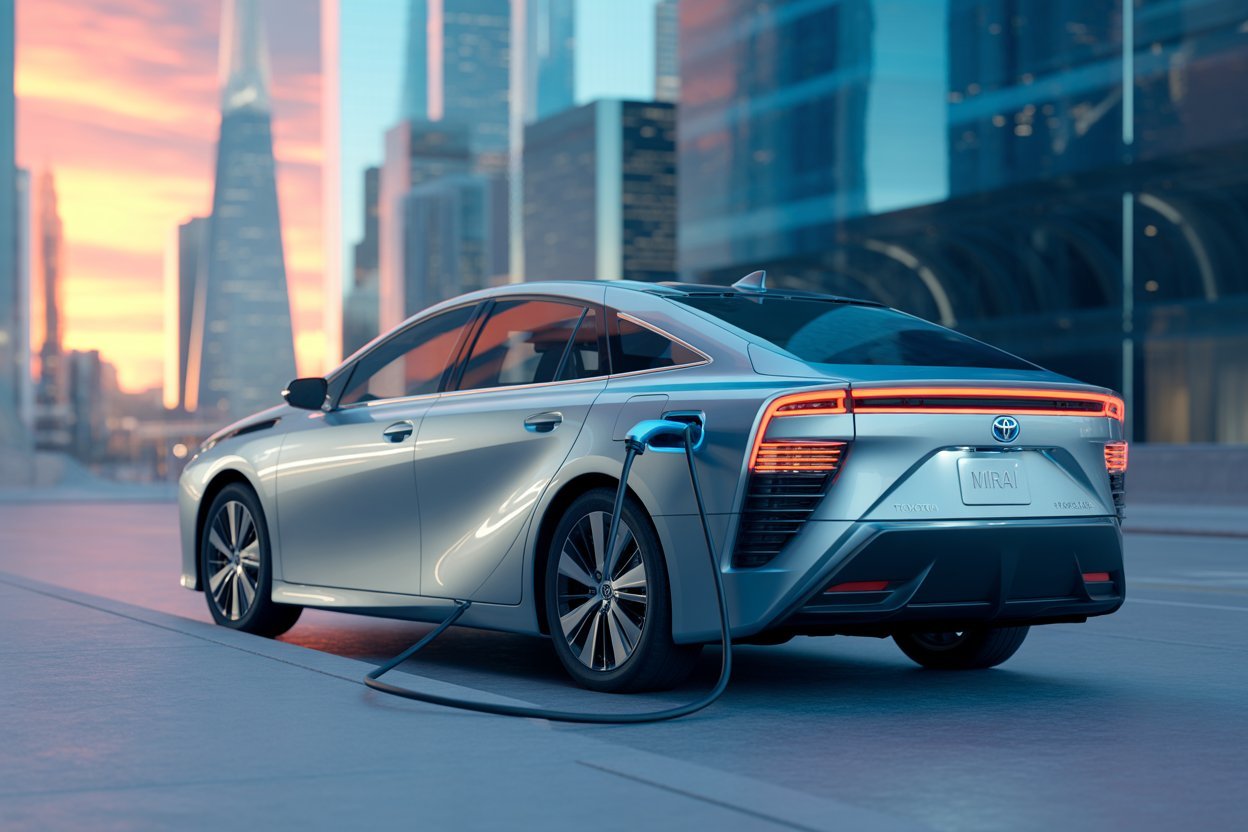
Hydrogen cars are electric vehicles that make their own electricity onboard. Instead of charging a battery from the grid, Fuel-Cell Electric Vehicles (FCEVs) feed compressed hydrogen (H₂) to a fuel-cell stack, which combines it with oxygen from air to produce electricity and water vapor. That electricity powers the traction motor, much like a BEV (battery EV). Key traits:
- Refuel in ~3–5 minutes at 700 bar (typical light-duty station standard).
- Range ~500–650 km per fill on current models like the Toyota Mirai.
Hydrogen cars are different from:
- Hydrogen ICE vehicles (H2-ICE): conventional engines adapted to burn H₂. They are simpler to integrate for heavy-duty or long-haul pilots but are not zero-emission (NOx can occur); still, they can run very clean with after-treatment and are being trialed for trucks/buses in India.
2) Why India Is Looking Beyond EVs
India’s mobility sector is huge, diverse, and climate-sensitive. Battery EVs are surging for two-wheelers, three-wheelers, and city cars; however, India’s geography and duty cycles also demand solutions for:
- High utilization fleets (city buses, intercity coaches, logistics trucks) need fast turnaround times and long range.
- Extreme climates and terrains (e.g., high-altitude Himalayan routes) where hydrogen pilots are already operating.
Hydrogen slots into a complementary role: focus on long-range, heavy-duty, continuous-use segments first, then expand to select private mobility segments as infrastructure grows.
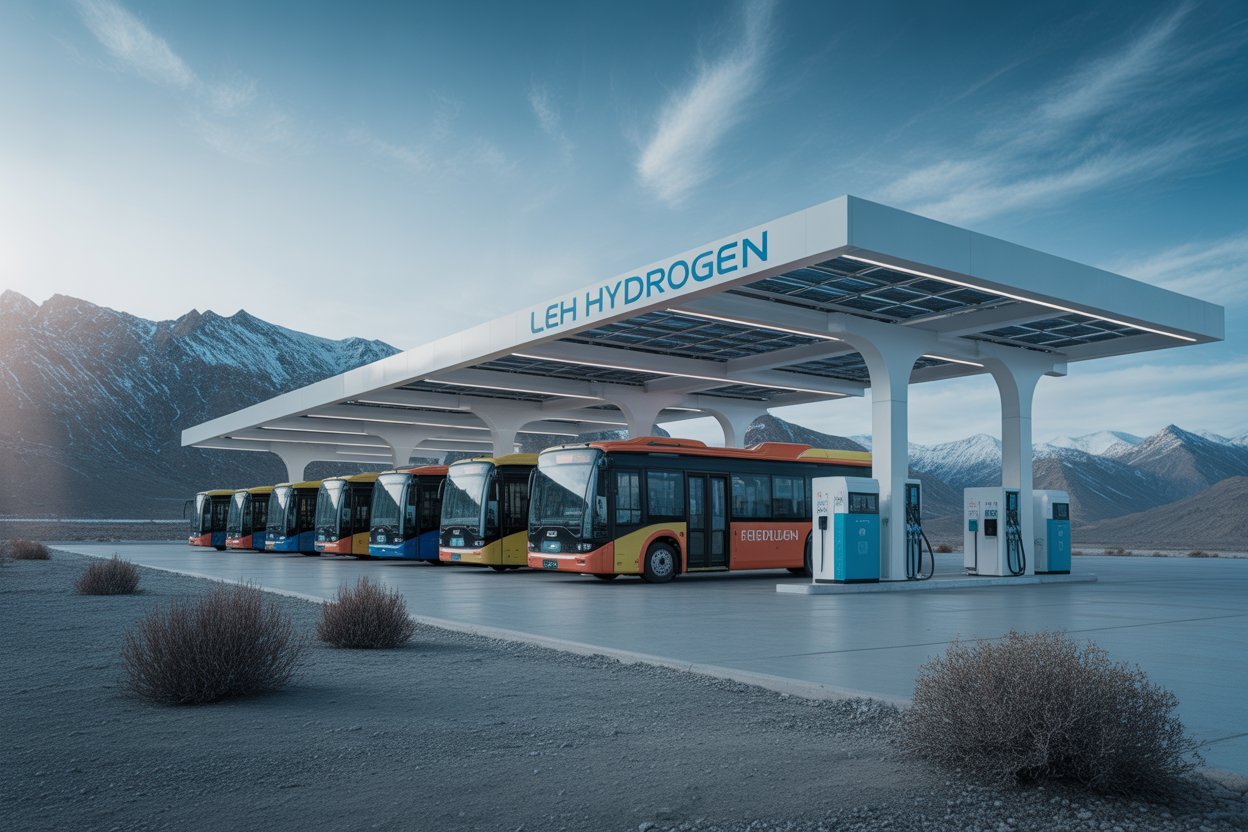
3) 2025 Snapshot: Where India Stands Today
- Green hydrogen strategy: India is targeting 5 MMT (million metric tonnes) per year of green hydrogen capacity by 2030 with ₹19,744 crore of government outlay under the National Green Hydrogen Mission, including ₹17,490 crore for the SIGHT scheme (manufacturing & offtake incentives).
- Refueling & pilots: India’s first green H₂ refueling station for high-altitude operations was commissioned at Leh, Ladakh, to support five NTPC hydrogen buses; commercial service in Leh has begun.
- Mobility pilots expanding: MNRE has sanctioned five pilot projects deploying 37 hydrogen buses and trucks (15 fuel-cell, 22 H2-ICE) with nine refueling stations on selected corridors.
- Ambition & industry response: Recent statements suggest India aims to meet ~10% of global green H₂ demand by 2030; electrolyzer capacity is being allocated under SIGHT.
4) Policy Backbone: National Green Hydrogen Mission (NGHM) & Standards
NGHM at a glance
- Outlay: ₹19,744 crore total; SIGHT (Strategic Interventions for Green Hydrogen Transition) gets ₹17,490 crore; pilots ₹1,466 crore; R&D ₹400 crore; hubs & other components ₹388 crore.
- Targets: At least 5 MMT/yr green hydrogen capacity by 2030; ~125 GW of associated renewable energy; job creation and import reduction.
- Hubs: At least two Green Hydrogen Hubs in the initial phase to cluster production, offtake, and logistics.
Green Hydrogen Standard (what counts as “green”)
- India set a 2 kg CO₂e per kg H₂ (well-to-gate, 12-month average) emissions threshold for green hydrogen, covering electrolysis and biomass-based H₂. This definition underpins certification and trade.
Demand creation levers
- The government is piloting mobility deployments (buses/trucks) and exploring consumption obligations in refining and fertilizer sectors to anchor demand similar to RPOs in renewables. Industry has also called for Hydrogen Purchase Obligations (HPOs) to avoid stranded assets.
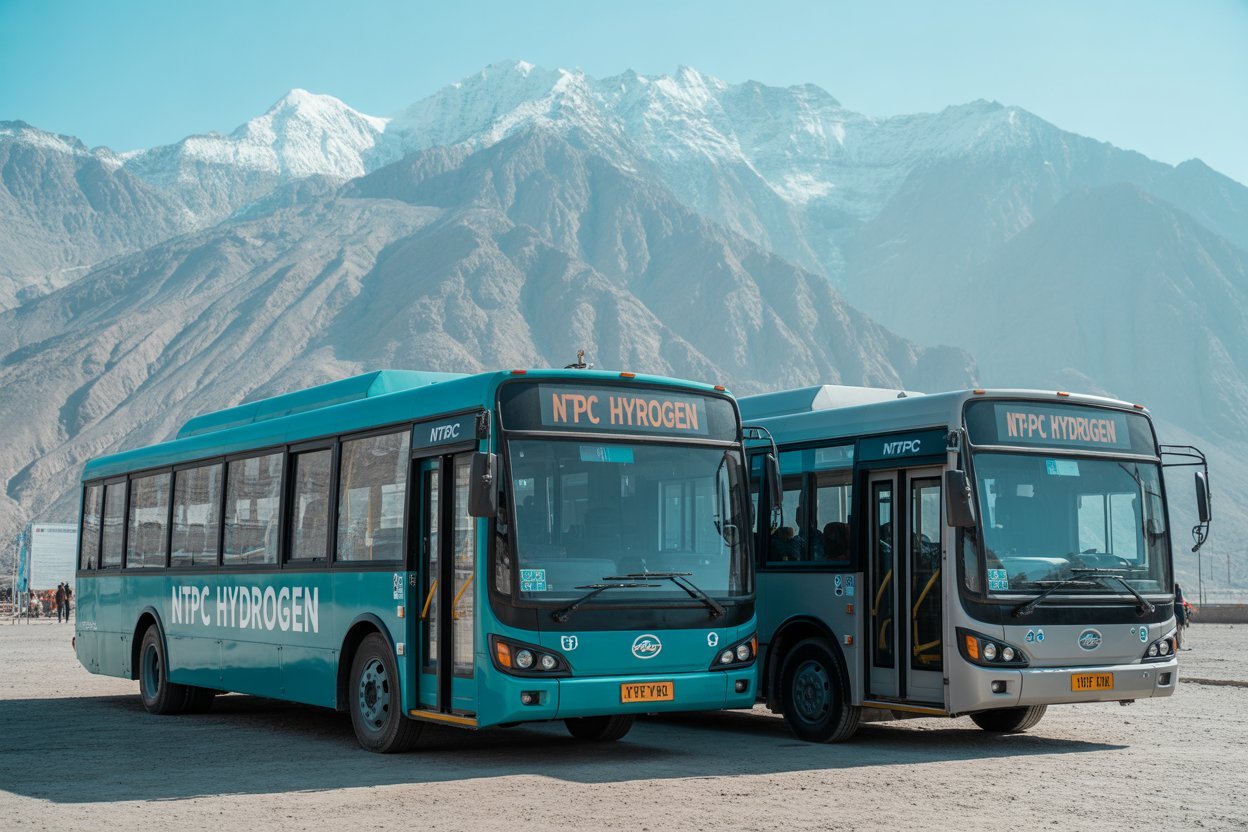
5) Refueling Infrastructure: Where Can You Fill Hydrogen Today?
- Leh, Ladakh: High-altitude green hydrogen station developed for NTPC’s bus operations, a national first and a global showcase for extreme conditions.
- Corridor pilots: Under MNRE’s sanctioned projects, nine H₂ stations are slated along specific routes to support 37 pilot vehicles (buses and trucks).
- Oil marketing companies (OMCs), including Indian Oil, have announced plans to scale green hydrogen production and set up more stations as part of their net-zero and refinery decarbonization roadmaps.
Bottom line: Public retail hydrogen availability for private cars is still very limited in 2025, but rapidly evolving via pilot corridors and hubs.
6) Pilot Projects & Early Deployments (Buses, Trucks, Cars)
NTPC’s Ladakh hydrogen buses
- Five hydrogen fuel-cell buses were handed over to the Leh administration; operations supported by a green H₂ station in Leh (inaugurated in late 2024), enabling commercial service in challenging high-altitude conditions.
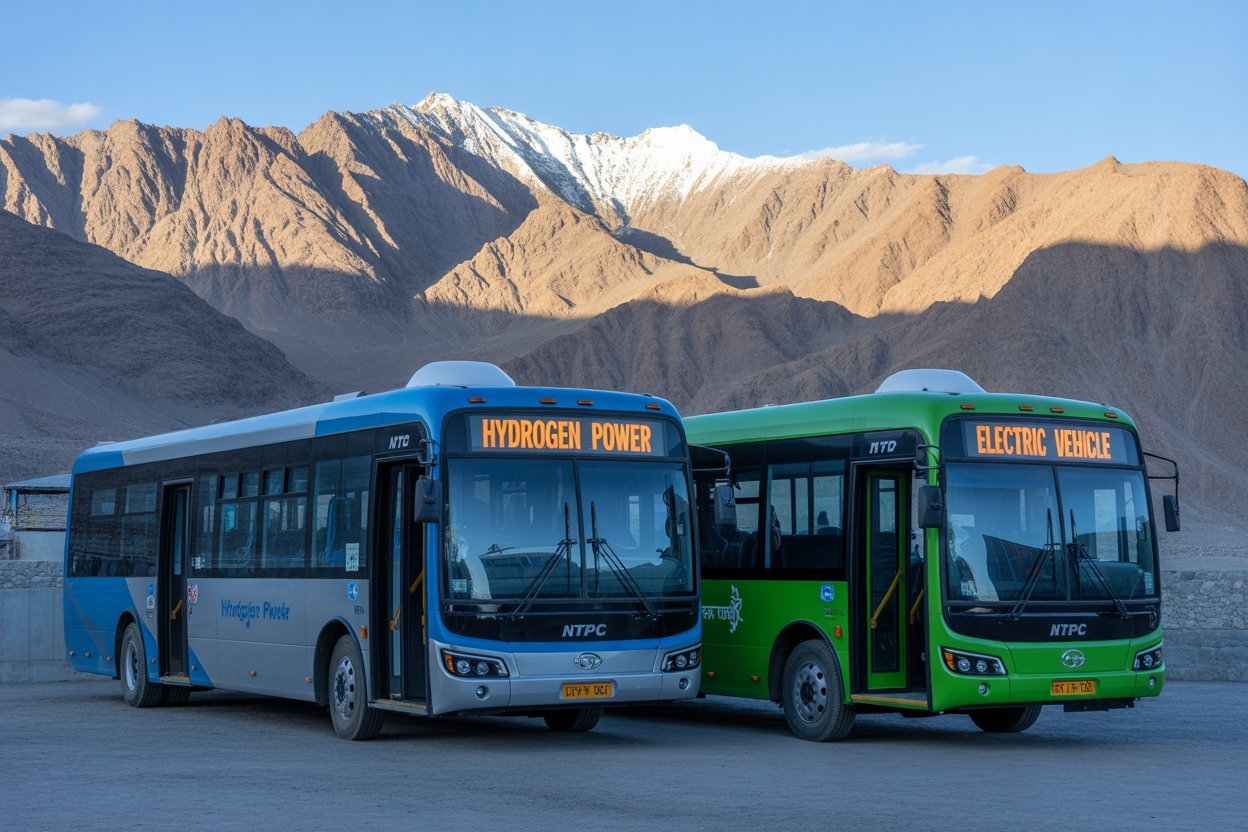
MNRE Mobility Pilots
- Five pilot projects sanctioned: 37 vehicles total (15 fuel-cell, 22 H2-ICE) and nine refueling stations to test real-world operations across key routes.
Toyota Mirai government pilot
- India launched its first green H₂ fuel-cell EV pilot with the Toyota Mirai, demonstrating ~650 km range with ~5-min refuelling. While not yet sold retail in India, the Mirai continues to anchor demos & data collection.
State-level momentum
- States are exploring hydrogen mobility pilots; for instance, Odisha announced plans to introduce hydrogen buses in Bhubaneswar as part of a green transport push
7) Vehicles to Watch: Mirai, Nexo & Made-in-India Momentum
- Toyota Mirai (FCEV): Mid-size sedan, ~650 km range, fast refuel; used in India’s government-backed trials (not yet retail).
- Hyundai Nexo (FCEV): Globally, ~600 km range; showcased in India events; potential candidate as stations expand (status: not retail in India). (Range benchmark from global sources; India retail pending.)
- Indian OEMs (buses & trucks):
- Tata Motors: Actively participating in hydrogen pilots (FCEV buses/trucks).
- Ashok Leyland: Pioneering H2-ICE heavy-duty concepts for long-haul freight.
- Multiple suppliers and EPCs are building local capability (electrolyzers, storage, compression, dispensing).
8) Hydrogen vs Battery EVs: Efficiency, Emissions & Use-Cases
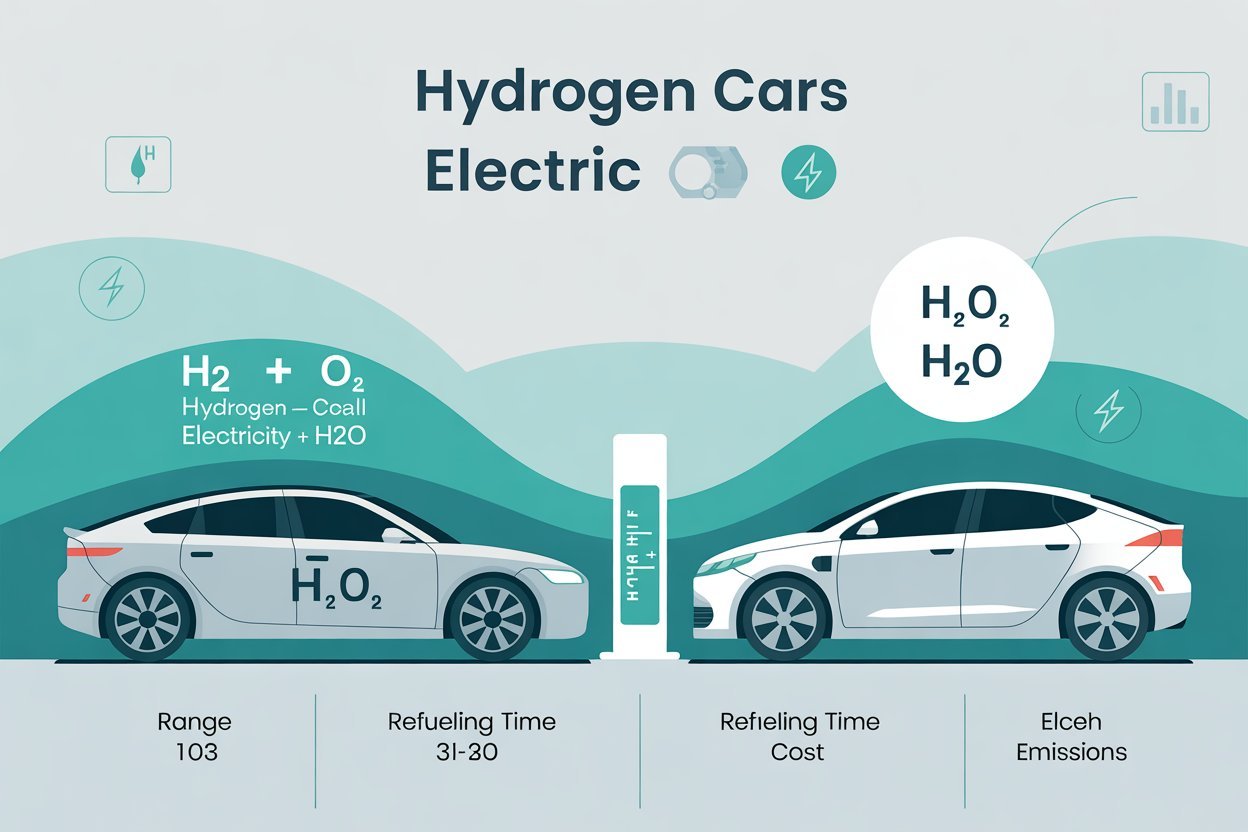
Energy efficiency (why BEVs still win for many cars)
Independent analyses indicate battery EVs convert a higher share of input electricity to wheel motion (~70–90%) compared to the well-to-wheel chain for hydrogen (renewable electricity → electrolysis → compression/liquefaction → transport → fuel cell), which incurs larger losses. This is why BEVs often dominate light-duty markets on energy cost and efficiency.
Emissions
When produced to India’s standard, green hydrogen must meet ≤ 2 kg CO₂e per kg H₂ (well-to-gate average), ensuring very low lifecycle emissions for mobility. Meanwhile, BEVs’ emissions depend on grid mix; as India’s grid greens, BEVs get cleaner over time. Both pathways can deliver deep decarbonization with the right upstream inputs.
Where hydrogen shines first
- High-utilization fleets that need fast refueling and long range (e.g., city buses that can’t afford long charging downtimes).
- Heavy trucks where payload and duty cycles challenge current battery tech.
- Extreme climates/terrain (e.g., high-altitude Leh) where H₂ pilots are already operating.
Takeaway: Expect BEVs to dominate mainstream passenger cars, while hydrogen grows first in fleets, buses, and heavy-duty then expands as stations and volumes rise.
9) Economics: Cost per kg, TCO, and What Must Change
Cost drivers for hydrogen mobility
- Hydrogen production cost (electrolyzer capex + renewable electricity price).
- Compression/storage/dispensing (CAPEX & OPEX at stations).
- Vehicle cost (fuel-cell stacks, high-pressure tanks).
- Utilization (the more kg/day a station sells, the lower the per-kg cost).
India’s NGHM and SIGHT schemes aim to localize electrolyzers, lower costs, and scale demand with pilots and potential obligations, all of which should push H₂ toward cost parity in targeted segments through the decade.
TCO (Total Cost of Ownership)
For buses and trucks where daily kilometers are high and downtime is costly, TCO can swing in hydrogen’s favor once fuel cost drops and station utilization is strong. Early pilots (like Leh) are there to build the operational data India needs to calibrate subsidies and scale commercially.
10) Safety: Myths vs Facts
- Hydrogen is lighter than air and disperses rapidly outdoors; stations and vehicles use redundant sensors, leak detection, and venting.
- Automotive tanks are carbon-fiber composite and rigorously tested (burst, impact, fire).
- Stations follow international codes for setbacks, ventilation, and emergency response.
- India’s pilots provide local safety learnings for codes and standards at the infra scales. (General technical facts; India’s standard covers emissions, not safety; safety codes are applied via international best practices during pilots.)
11) Consumer Readiness: Buying, Servicing, Insurance, Resale
As of 2025, hydrogen cars are not yet on open retail sale in India. Practical implications:
- Refueling access: Public stations are limited; pilots rely on captive depots (fleet first).
- Service & parts: OEMs running pilots (Toyota, bus/truck OEMs) provide trained technicians and spares through project agreements.
- Insurance & resale: Will mature with retail availability and actuarial data; early adopters will likely be fleets under OEM-service SLAs.
- Registration & incentives: Expect tailored state policies to emerge alongside central schemes as hubs expand.
12) Sector Outlook to 2030: What Experts Expect
- Production scale-up: India is pursuing 5 MMT/yr green H₂ by 2030; electrolyzer manufacturing is being allocated under SIGHT.
- Demand anchors: Refining & fertilizer sectors are expected to act as anchor offtakers, with mobility benefitting from the shared hydrogen ecosystem.
- Mobility ramp-up: More city bus and logistics corridor pilots in the near term; select states/cities (with green-energy resources and port proximity) could adopt earlier.
- Export ambition: India is signaling intent to capture a share of global green H₂ trade by 2030, which can accelerate domestic capacity, lower costs, and enable station rollouts.
13) City & State Spotlight: Where Adoption May Accelerate First
- Ladakh/Leh: Operational showcase for high-altitude hydrogen buses and green H₂ station, a global proof point.
- Port & industrial hubs: States with refineries, fertilizer plants, and ports (e.g., Gujarat, Maharashtra, Odisha) can link industrial hydrogen with mobility depots and export terminals. (Inference based on refinery/fertilizer & port clustering; specific projects often announced via OMCs and state policies.)
- Announced state pilots: Odisha/Bhubaneswar planning hydrogen buses.
15) Actionable Checklist for Fleet Owners & Policymakers
For fleet operators (bus/truck/logistics):
- Map duty cycles where range + uptime are critical; short-list hydrogen candidates.
- Engage with MNRE/State nodal agencies to participate in pilot corridors and access incentives.
- Plan depot-based refueling first; target >200–500 kg/day utilization for viable station economics (varies by design).
- Build TCO models with fuel cost sensitivity; include stack warranties, tank inspection cycles, and station O&M.
For city/state governments:
- Co-site green H₂ production (electrolyzers + renewables) with bus depots to reduce logistics.
- Use city bus tenders to seed demand (Gross Cost Contract models).
- Earmark land & permits for stations along logistics corridors.
- Align with NGHM hubs and leverage SIGHT incentives.
Conclusion
Hydrogen cars in India have moved from concept to credible pilots. With NTPC’s Ladakh buses in service, MNRE’s multi-route pilots green-lit, and the Toyota Mirai data-gathering continuing, India is systematically testing hydrogen mobility in the right segments. Policy clarity under the National Green Hydrogen Mission and the Green Hydrogen Standard provides the regulatory rails for investment, certification, and trade.
The near-term reality: BEVs remain the most efficient choice for mass passenger adoption, while hydrogen is poised to lead in buses, long-haul trucks, and high-utilization fleets, especially where fast refueling and long range matter.
Over the next five years, expect more stations on pilot corridors, bigger fleets, and the first limited retail opportunities as costs fall and infrastructure scales. India isn’t choosing between batteries and hydrogen; it’s building both, and that balanced strategy is exactly how the country will decarbonize mobility faster.
“Want to stay updated on India’s green mobility revolution? Subscribe to Vishwakhabar’s newsletter and never miss an update on EVs, hydrogen cars, and future technologies.”
Q1. Are hydrogen cars available for private purchase in India?
As of 2025, hydrogen cars like the Toyota Mirai are being tested under government-backed pilots but are not yet available for retail purchase in India. Fleets and pilot projects are the main focus right now.
Q2. How do hydrogen cars work?
Hydrogen cars are Fuel-Cell Electric Vehicles (FCEVs). They use a fuel cell that combines hydrogen with oxygen from the air to generate electricity, which powers the motor. The only by-product is water vapor.
Q3. How long does it take to refuel a hydrogen car?
Hydrogen cars can be refueled in 3–5 minutes for ~500–650 km on today’s models, similar to filling a petrol or diesel tank, giving them a significant advantage over long EV charging times.
Q4. What is the driving range of hydrogen cars?
Most hydrogen cars, like the Toyota Mirai, can drive around 500–650 km on a full tank, making them comparable to petrol and diesel vehicles in range.
Q5. Where are hydrogen refueling stations in India?
At present, hydrogen refueling stations are limited to pilot projects. The first green hydrogen refueling station was set up in Leh, Ladakh, and more stations are planned across pilot corridors by MNRE and OMCs.
Q6. Are hydrogen cars safe?
Yes. Hydrogen vehicles use high-pressure carbon-fiber tanks tested for crashes, leaks, and fire. Hydrogen is lighter than air, so it disperses quickly in case of leakage.
Q7. How much does hydrogen fuel cost in India?
Hydrogen costs in India are still high (₹400–500 per kg) because production and distribution are limited. However, with the National Green Hydrogen Mission (NGHM), costs are expected to drop significantly by 2030.
Q8. Which companies are working on hydrogen vehicles in India?
Toyota: Mirai (pilot project)
Hyundai: Nexo (showcased, not yet launched in India)
Tata Motors: Hydrogen fuel-cell buses
Ashok Leyland: Hydrogen ICE trucks and buses
NTPC: Hydrogen bus fleet in Leh
Q9. Will hydrogen replace EVs in India?
Not entirely. Experts believe EVs will dominate short-distance passenger cars, while hydrogen will play a bigger role in buses, trucks, and long-range fleet vehicles where fast refueling and heavy loads are required.
Q10. What is the future of hydrogen cars in India?
By 2030, India aims to build large-scale hydrogen hubs, more refueling stations, and expand hydrogen mobility pilots into city buses and freight corridors. Hydrogen cars will gradually move into select retail segments as infrastructure improves.
Q11. How many hydrogen stations does India have?
Publicly accessible retail stations are very limited; Leh, Ladakh, has a green H₂ station for NTPC buses, and the MNRE pilots provide for nine stations along selected corridors.
Q12. Are hydrogen cars cleaner than EVs?
Both can be ultra-low-carbon. India’s Green Hydrogen Standard caps emissions at ≤ 2 kg CO₂e/kg H₂ (well-to-gate). BEV emissions depend on grid mix; as the grid decarbonizes, BEVs get cleaner.
Q13. Why pursue hydrogen if BEVs are more efficient?
Use-case fit. Hydrogen suits high-utilization, long-range duty cycles (buses, trucks, fleet cars) demanding fast refueling and high uptime; BEVs dominate urban light-duty. India is wisely pursuing both.